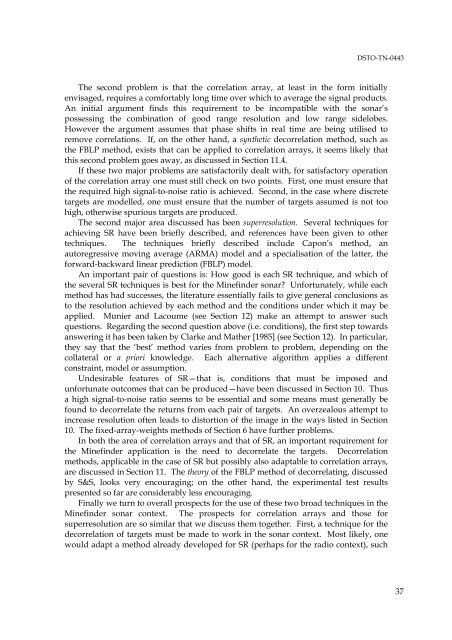Suitability of Correlation Arrays and Superresolution for Minehunting ...
Suitability of Correlation Arrays and Superresolution for Minehunting ...
Suitability of Correlation Arrays and Superresolution for Minehunting ...
Create successful ePaper yourself
Turn your PDF publications into a flip-book with our unique Google optimized e-Paper software.
DSTO-TN-0443<br />
The second problem is that the correlation array, at least in the <strong>for</strong>m initially<br />
envisaged, requires a com<strong>for</strong>tably long time over which to average the signal products.<br />
An initial argument finds this requirement to be incompatible with the sonar’s<br />
possessing the combination <strong>of</strong> good range resolution <strong>and</strong> low range sidelobes.<br />
However the argument assumes that phase shifts in real time are being utilised to<br />
remove correlations. If, on the other h<strong>and</strong>, a synthetic decorrelation method, such as<br />
the FBLP method, exists that can be applied to correlation arrays, it seems likely that<br />
this second problem goes away, as discussed in Section 11.4.<br />
If these two major problems are satisfactorily dealt with, <strong>for</strong> satisfactory operation<br />
<strong>of</strong> the correlation array one must still check on two points. First, one must ensure that<br />
the required high signal-to-noise ratio is achieved. Second, in the case where discrete<br />
targets are modelled, one must ensure that the number <strong>of</strong> targets assumed is not too<br />
high, otherwise spurious targets are produced.<br />
The second major area discussed has been superresolution. Several techniques <strong>for</strong><br />
achieving SR have been briefly described, <strong>and</strong> references have been given to other<br />
techniques. The techniques briefly described include Capon’s method, an<br />
autoregressive moving average (ARMA) model <strong>and</strong> a specialisation <strong>of</strong> the latter, the<br />
<strong>for</strong>ward-backward linear prediction (FBLP) model.<br />
An important pair <strong>of</strong> questions is: How good is each SR technique, <strong>and</strong> which <strong>of</strong><br />
the several SR techniques is best <strong>for</strong> the Minefinder sonar? Un<strong>for</strong>tunately, while each<br />
method has had successes, the literature essentially fails to give general conclusions as<br />
to the resolution achieved by each method <strong>and</strong> the conditions under which it may be<br />
applied. Munier <strong>and</strong> Lacoume (see Section 12) make an attempt to answer such<br />
questions. Regarding the second question above (i.e. conditions), the first step towards<br />
answering it has been taken by Clarke <strong>and</strong> Mather [1985] (see Section 12). In particular,<br />
they say that the ‘best’ method varies from problem to problem, depending on the<br />
collateral or a priori knowledge. Each alternative algorithm applies a different<br />
constraint, model or assumption.<br />
Undesirable features <strong>of</strong> SR—that is, conditions that must be imposed <strong>and</strong><br />
un<strong>for</strong>tunate outcomes that can be produced—have been discussed in Section 10. Thus<br />
a high signal-to-noise ratio seems to be essential <strong>and</strong> some means must generally be<br />
found to decorrelate the returns from each pair <strong>of</strong> targets. An overzealous attempt to<br />
increase resolution <strong>of</strong>ten leads to distortion <strong>of</strong> the image in the ways listed in Section<br />
10. The fixed-array-weights methods <strong>of</strong> Section 6 have further problems.<br />
In both the area <strong>of</strong> correlation arrays <strong>and</strong> that <strong>of</strong> SR, an important requirement <strong>for</strong><br />
the Minefinder application is the need to decorrelate the targets. Decorrelation<br />
methods, applicable in the case <strong>of</strong> SR but possibly also adaptable to correlation arrays,<br />
are discussed in Section 11. The theory <strong>of</strong> the FBLP method <strong>of</strong> decorrelating, discussed<br />
by S&S, looks very encouraging; on the other h<strong>and</strong>, the experimental test results<br />
presented so far are considerably less encouraging.<br />
Finally we turn to overall prospects <strong>for</strong> the use <strong>of</strong> these two broad techniques in the<br />
Minefinder sonar context. The prospects <strong>for</strong> correlation arrays <strong>and</strong> those <strong>for</strong><br />
superresolution are so similar that we discuss them together. First, a technique <strong>for</strong> the<br />
decorrelation <strong>of</strong> targets must be made to work in the sonar context. Most likely, one<br />
would adapt a method already developed <strong>for</strong> SR (perhaps <strong>for</strong> the radio context), such<br />
37

















